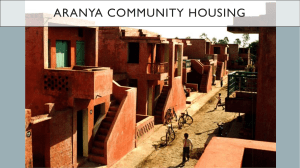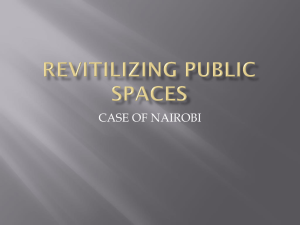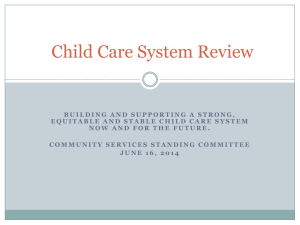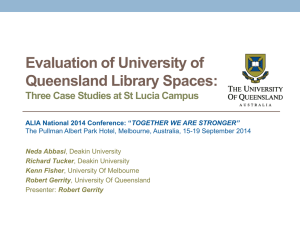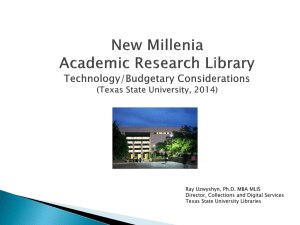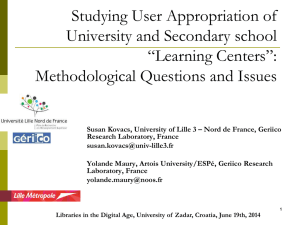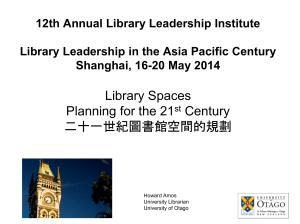case study- aaryana housing
advertisement
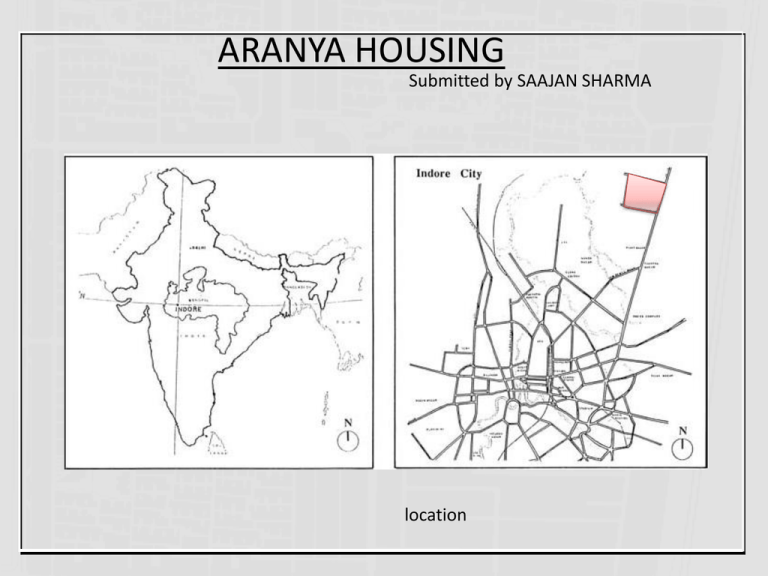
ARANYA HOUSING Submitted by SAAJAN SHARMA location Case study“ARANYA” A housing project, Indore Situated 6 km from Indore, Madhya Pradesh is a housing project for the middle and lower income groups of Indian population. Designed by architect B. V. Doshi of Vastu-Shilp Foundation, ‘Aranya’, was awarded the Aga Khan Award for Architecture in 1995. Case study“ARANYA” A housing project, Indore The general objectives or ARANYA were: 1- To create a township where a sense of continuity of fundamental values of security exist and to plan a good living environment. 2. To achieve a settlement character by establishing a harmony between the built environment and the people. 3. To create a balanced community of various socio-economic groups encouraging co-operation, fraternity , tolerance and self help generated through a physical planning process. 4. To evolve a framework within design where incremental physical development can take place within legal, economical and organizational framework. Case study“ARANYA” A housing project, Indore 1 2 Plan initially prepared by Indore development authority which shows a typical rubber stamping attitude without any concern for open space hierarchy , circulation system , climatic orientation or the built form. Basic grid pattern envisaged for simple layout Initial stage proposed plan with distributed open spaces and street hierarchies. and introduced discourage traffic. Twists staggers to through HOUSING PLANNING 3 4 Later stage of development with rectified orientation to minimize heat gain and increase natural shading. Clear hierarchy to be obtained. Proposed master plan with interlinked open spaces, built form variations, distributed amenities, road network hierarchies and climate friendly orientation Housing catagories •The master plan was divided into six sectors with a central spine area of commercial and institutional land use. •The town centre in the middle part of the spine consisted of four clusters of shopping, residential and office complexes. Housing catagories •The high income group (HIG 9 per cent), is along the periphery of the national highway and part on the south east border of the arterial road in the south. •The middle income group (MIG 14 %) is planned along the periphery of arterial roads on north – west side and part on the south arterial road along the part of the spine. •The lower income group (LIG 11%)and the economically weaker sector (EWS 65%) are located in the middle of all six sectors. DIVISION OF SPACES Residential : 58 % Pedestrian : 24% Open spaces : 7% Commercial : 8% SPACE USE pedestrian 25% open space 8% Other 15% residential 60% commercial facility 7% ANALYSIS OF THE PLANNING 1. Houses have been clustered in groups of ten, separated by open spaces. 2. Each sector with main pedestrian street. 3. Otta, a transitional zone , is provided in front of each house which is located between private and public space . 4.Ottas are provided as a meeting place or interactive place. 5. A septic tank was provided for two clusters. BASIC PLAN OF A HOUSE/UNIT • A house plan included two rooms and a living area followed by a kitchen . • Lavatory was constructed between the front extension and the multi use courtyard at the back. • Most houses were provided with an additional access at the back , which allowed for keeping animals, a vehicle or even renting out part of the house to provide income. • For interaction of families an otta (an important feature of the Indian home) was provided between the service spaces and the cul-de-sac. • A service core was provided with the prime objective that the basic house when completed will be sensitive to the lifestyle and daily needs of individuals with the freedom to integrate indoor and outdoor spaces with privacy within and from outside the homes, by designing optional plan. • A cluster of ten houses were connected to 1 inspection chamber and 20 houses to one septic tank. • A conventional sewage system was developed for the township, keeping in view the general contour of available ground slope and the road network. •A well and a lift station were provided near the final manhole that discharges the waste water into the treatment plant, • An oxidation pond on the north west corner of the site where the natural slope helped in collecting the sewage and was suitable for the predominant south west wind direction to avoid odour pollution. SERVICES SERVICES •The road network, designed according to the topography, allowed for smooth gravitational flow of water. Three reservoirs, each serving two sectors were located at higher points of sector and were interconnected in such a way that any two could cover the entire population. •The system adopted for storm water drainage was a combination of an underground storm water system in wider roads and surface drainage on internal roads where ground slopes were effectively used. The road section dropped below ground level by six inches, allowing it to act as the drain. SERVICES •As shown in option 1 the conventional method of placing toilets in front goes against cultural and aesthetic priorities and manages to connect eight toilets to one manhole with sewerage line every on street. As in option 2, 3 and 4 toilets at back create maintenance related problem. 1 3 2 4 CONCLUSION 1.Locally available building materials used for low cost housing. 2. Interactive spaces are created e.g. ottas and pedestrians. 3. No parking space provided due to majority consists of EWS/LIG groups. 4.Extensions such as balconies, open stairs and porches acts as both indoor and outdoor characters. COCLUSION • • • • • • Community facilities grouped in local sub centers Formal organisation Community facilities distributed evenly Informality created Accessibility improved Lower level Community facilities organised in green spaces . • The road network, designed according to the topography, allowed for smooth gravitational flow of water.

